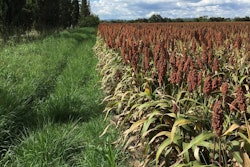Since the implementation of Colombia’s free trade agreement with the United States in 2012, that country has grown to become the third largest export market for U.S. corn, the seventh largest market for U.S. sorghum and the 15th largest market for U.S. distiller’s dried grains with solubles (DDGS). Both the FTA and Colombia’s proximity to the United States means our work to realize the potential in this market is just beginning, with the possibility of increased, long-term demand for U.S. grain products given the right market development and trade servicing work.
Colombia: Focused on demand building
For nearly 30 years, the Council has been active in Colombia with programs focused on developing consistent markets within the broiler, laying poultry and swine sectors, which have grown rapidly as the country has become more stable and its economy has grown. In addition, these sectors have established checkoff programs, which have partnered with USGC-directed activities to help local industries become more innovative.
As Colombia has continued to achieve stability and peace, its growing population and urbanization bring additional demand for meat, milk and eggs, which is driving interest in purchasing U.S. coarse grains and co-products. For example, during the 1988/1989 marketing year, Colombia imported almost no U.S. corn. Since then, the country has grown to be a 4.3-million-metric-ton (169 million bushels) annual market for U.S. corn.
To help capitalize on this, the Council continues to partner with these sectors through outreach efforts to their checkoff members and in promoting new products such as DDGS and corn gluten meal (CGM).
Colombia FTA: A lesson in why trade policy matters
While DDGS, CGM and other U.S. coarse grains are able to enter Colombia with greater ease now that the FTA is in place, this trade policy success was a long time coming. Negotiations on the pact began in 2004, with the agreement signed on Nov. 22, 2006. Political challenges then took over, and it was six more years before the treaty was implemented and its benefits could be reaped by the Colombian industry and U.S. farmers.
For U.S. corn exports, this was a costly postponement. Until 2009, Colombia was the sixth largest U.S. corn market. Then, Colombia’s trade agreement with South America’s Mercosur nations (including Argentina and Brazil) reduced tariffs on corn from those origins to 6.9%. Meanwhile, U.S. corn still had a 15% tariff in place.
U.S. corn sales took a huge hit, dropping from almost 3 million tons (118.1 million bushels) in the 2008/2009 marketing year to 500,000 tons (19.7 million bushels) in 2010/2011.
By the time the agreement was finally entered into force on May 12, 2012, this loss of market share was difficult to overcome. And while the trade agreement was a significant step forward, it also meant new market development work needed to be done in that country.
Post-FTA: U.S. corn exports to Colombia boom
Power of the FTA was demonstrated quickly in Colombia, which returned to purchasing U.S. corn in 2014, handing the United States a 97.4% market share of the nearly 4-million-ton (157 million bushels) market.
The 2013 and 2014 U.S. corn crops exhibited excellent quality that, along with competitive prices and a favorable tariff rate quota (TRQ) established within the FTA, contributed to this large growth in demand for U.S. corn. This trend has continued through 2016, with Colombia filling its duty-free quota this May and taking more than 4.4 million tons (173 million bushels) from Sept. 1, 2015, through June 9, 2016.
The Council’s role in this success has included continually promoting the advantages of U.S. origin to interested buyers and end users, including freight rates, consistency of supply, transparency of the market and quality.
In addition, the Council is working to help local stakeholders build the Colombian industry’s animal and feed production capacity to meet its growing demand for meat, milk and eggs. This includes activities like meetings to present our corn quality reports; one-on-one sessions to discuss perceptions and concerns about U.S. corn quality; and seminars on contract specifications that teach Colombian buyers how to get the quality corn they demand.
Buyers also show interest in U.S. sorghum
U.S. corn was not the only commodity that received a duty-free quota under the FTA. U.S. sorghum has a yearly tariff rate quota (TRQ) in place in Colombia that was almost filled in 2015 and is well on its way to being filled for 2016.
The Council has been promoting U.S. sorghum in Colombia since before the FTA went into effect in 2012. However, sales there have faced obstacles including misperceptions that all sorghum contains tannins; a limited number of buyers continually monitoring the price markets; and only a handful of feed processors formulating sorghum in feed rations.
为了克服这些障碍,委员会邀请了buyers from Colombia to our Regional Buyers Conference and held animal nutrition seminars in addition to individual outreach to importing companies and grain users.
These efforts include bringing trade teams of Colombian end users to the United States to learn about purchasing U.S. sorghum and incorporating it into animal rations. These teams leave the country with renewed confidence in our ability to provide high-quality sorghum that fits their needs.
Bullish outlook for 2020, 2030 in new USGC report
While Colombian buyers’ and end-users’ interest in U.S. corn and sorghum has increased since the implementation of the FTA, there is significant room for more according to our new report, Outlook Colombia 2030. This report suggests that Colombia’s feed imports are likely to continue to expand significantly faster than historical trends would suggest, which would create new opportunities for U.S. grain exports.
The report showed U.S. corn exports to Colombia are projected to reach 5.5 million tons (216.5 million bushels) in 2020 and 7.8 million tons (307 million bushels) in 2030. Importantly, Colombia’s livestock sector is expected to increase output by more than 50% by 2030 from 2014 levels while the country’s lagging crop production performance is projected to continue, forcing Colombia’s livestock producers to depend on feed imports.
While this bullish outlook is exciting news, U.S. performance is by no means guaranteed, particularly since the United States continues to face strong competition from the Mercosur countries. In addition, Argentina’s recent elimination of its export tax on agricultural commodities could further erode the United States’ price competitiveness in Colombia.
In order to overcome these challenges, the Council is increasing its engagement in this market.
Building U.S. engagement in Colombian markets
USGC staff has learned from engagement with the feed and livestock industries in Colombia that the organization needs to ramp up work in this marketto encourage, shape and accelerate the future modernization of Colombia’s feed and livestock sectors.
The Council can do this by building partnerships with Colombian importers and manufacturers to ensure local delivery of attractively priced, nutritionally sound, species-specific rations, which will reinforce Colombian livestock operators’ interest in sector modernization.
In addition, the Council will need to continue to work with Colombian livestock producers to provide access to innovative technology and best livestock management practices. The Council has plans to do this by bringing trade teams to the United States, bringing expert nutritionists into the country to present the most up-todate feed formulation information and facilitating one-on-one meetings between U.S. animal specialists and Colombian end users.
Continuing to work in a competitive region
Colombia is an exciting market with significant potential for U.S. agricultural exports. However, it is also eager to expand its trading partners, with FTAs already in place with the United States, Canada and the European Union. In addition, it is negotiating new agreements with South Korea, Panama and Costa Rica and is part of a larger trade group called the Pacific Alliance.
While these trade agreements would be helpful to Colombia’s economic growth, they would also give these countries access to its growing coarse grains market. The Council knows this and is working continuously to promote the advantages of purchasing U.S. corn, sorghum and other products to this growing nation. ❚
Editor’s note: U.S. Grains Council is online atwww.grains.org. Readers can sign up for the USGC weekly newsletter athttps://usgc.informz.net/USGC/profile.asp





















